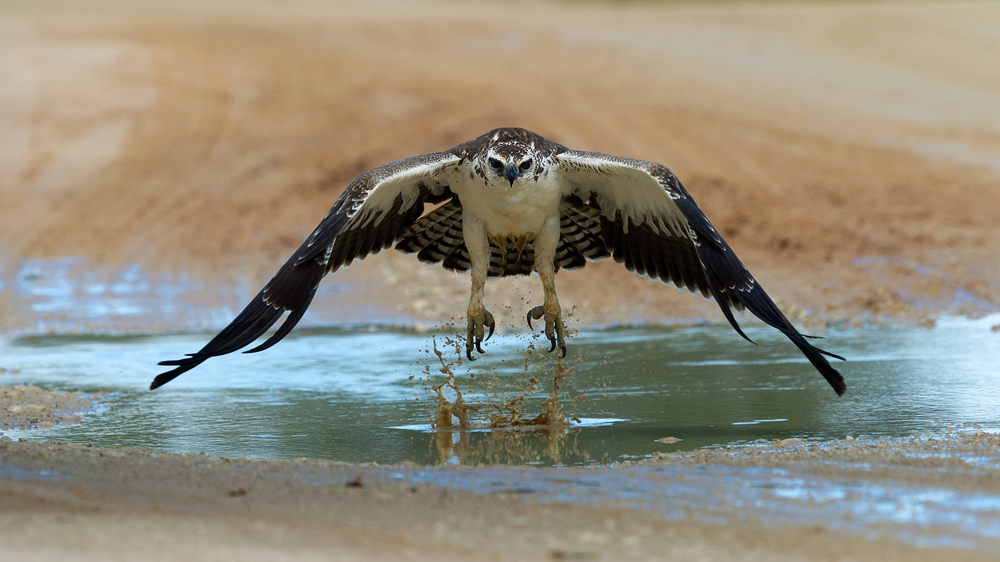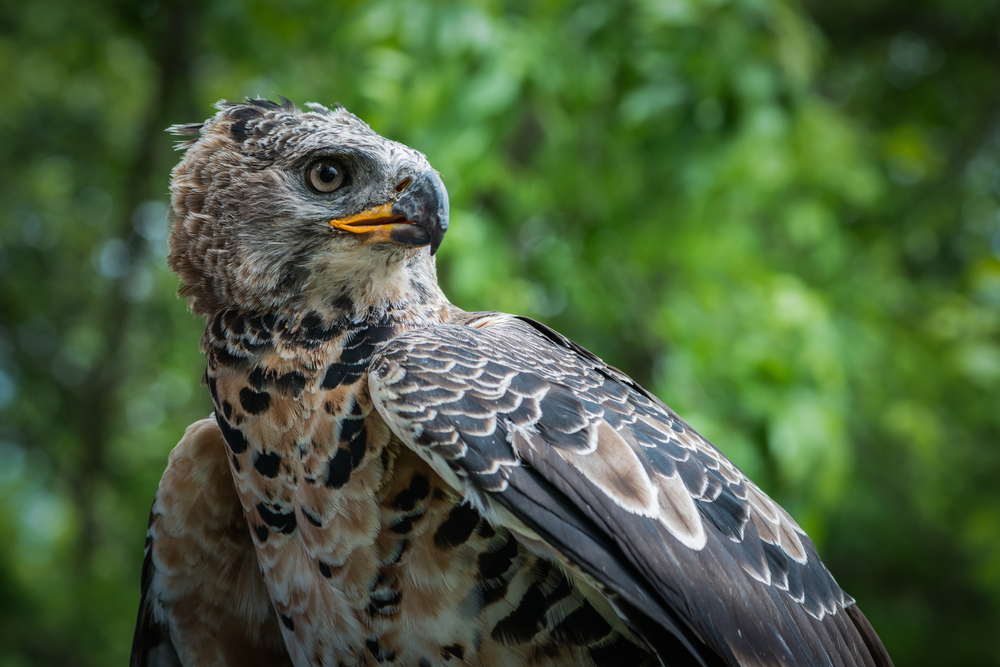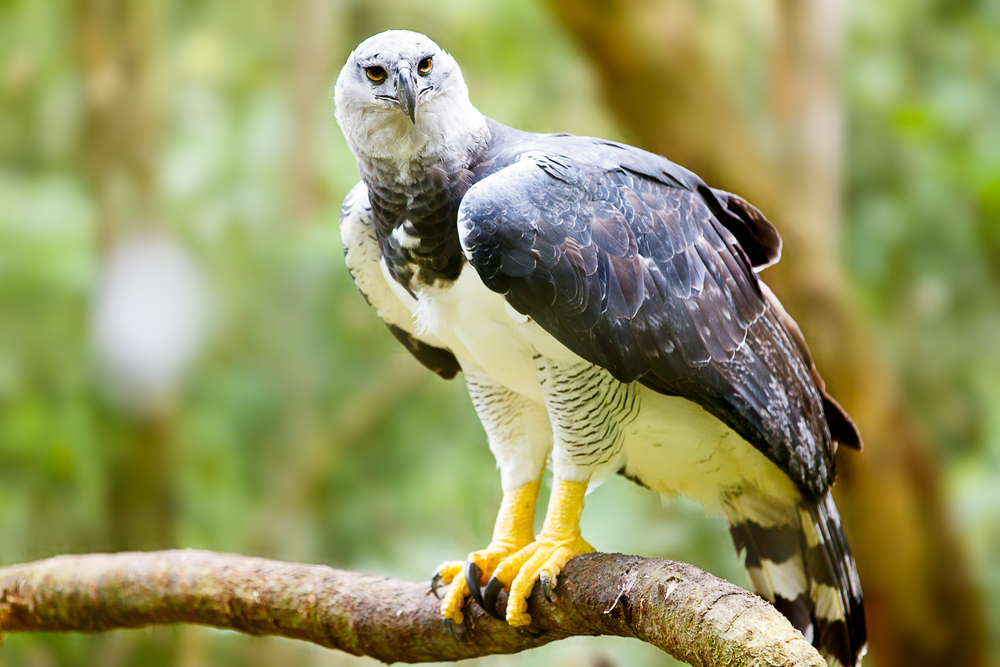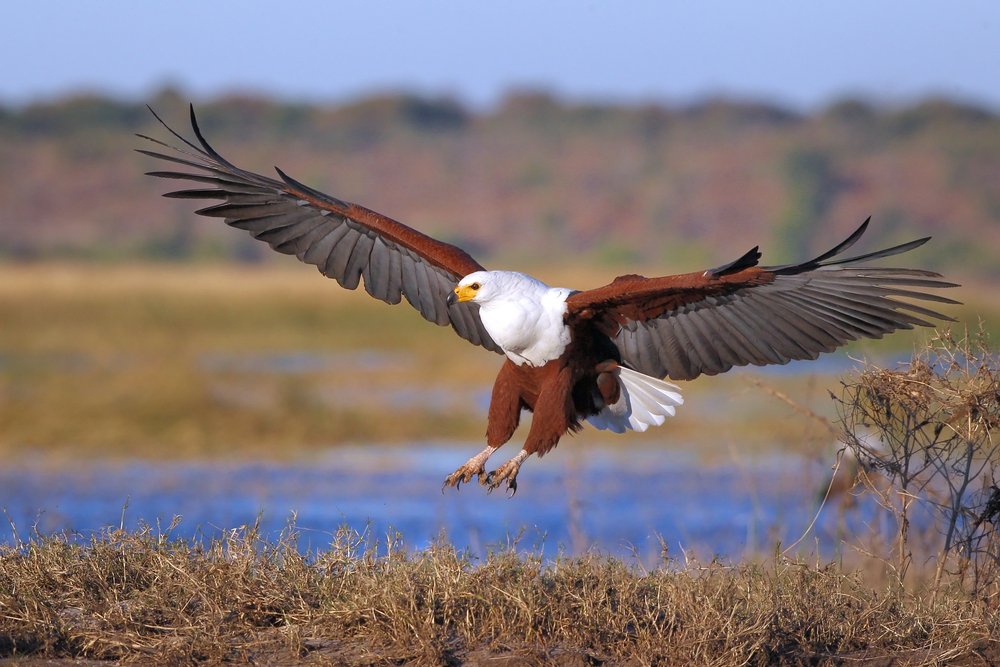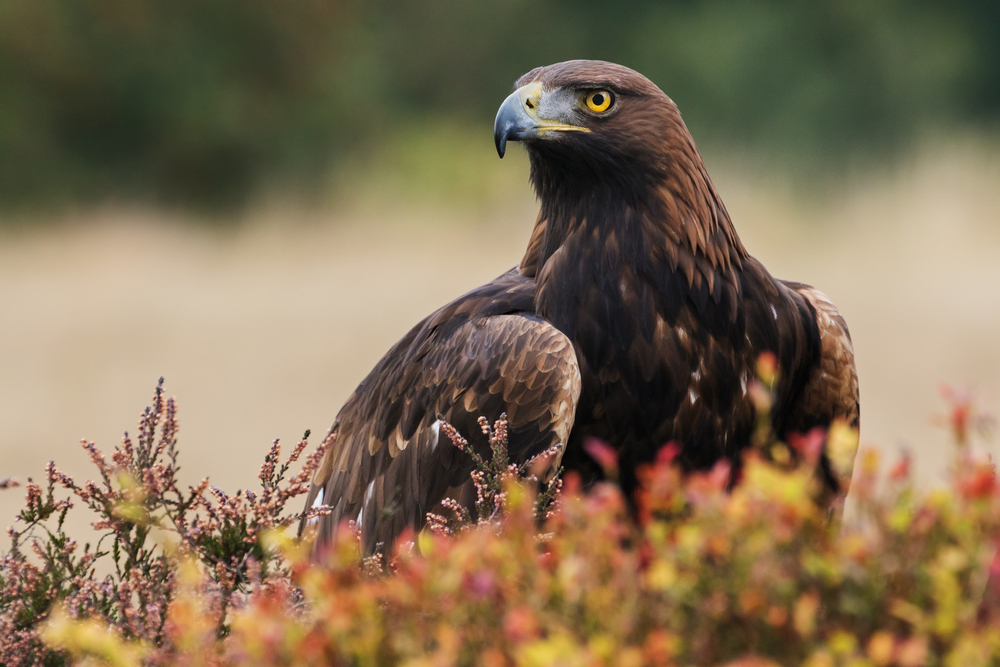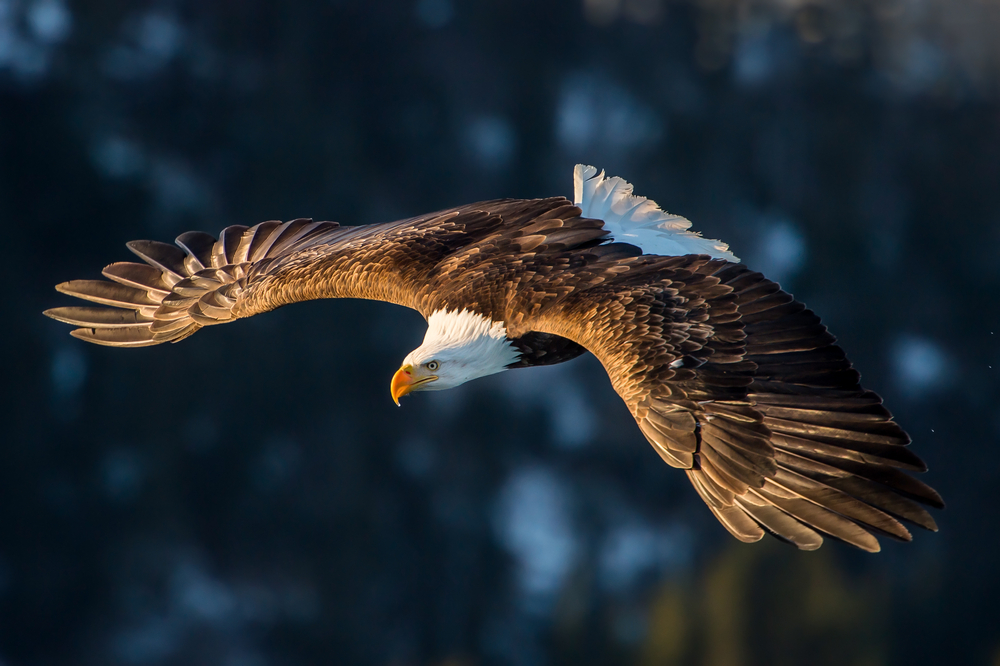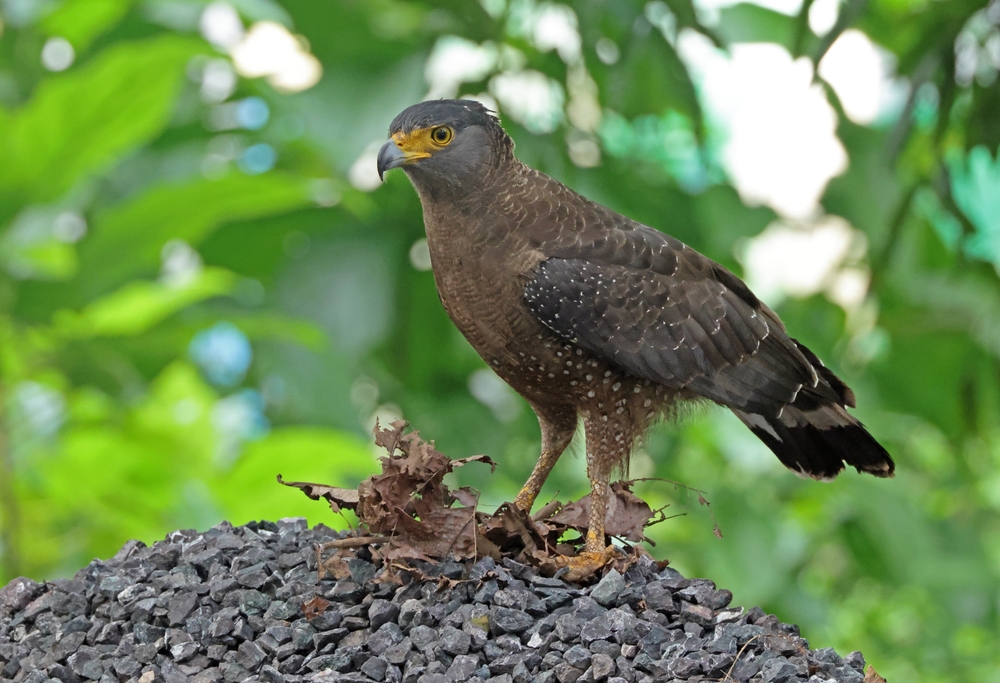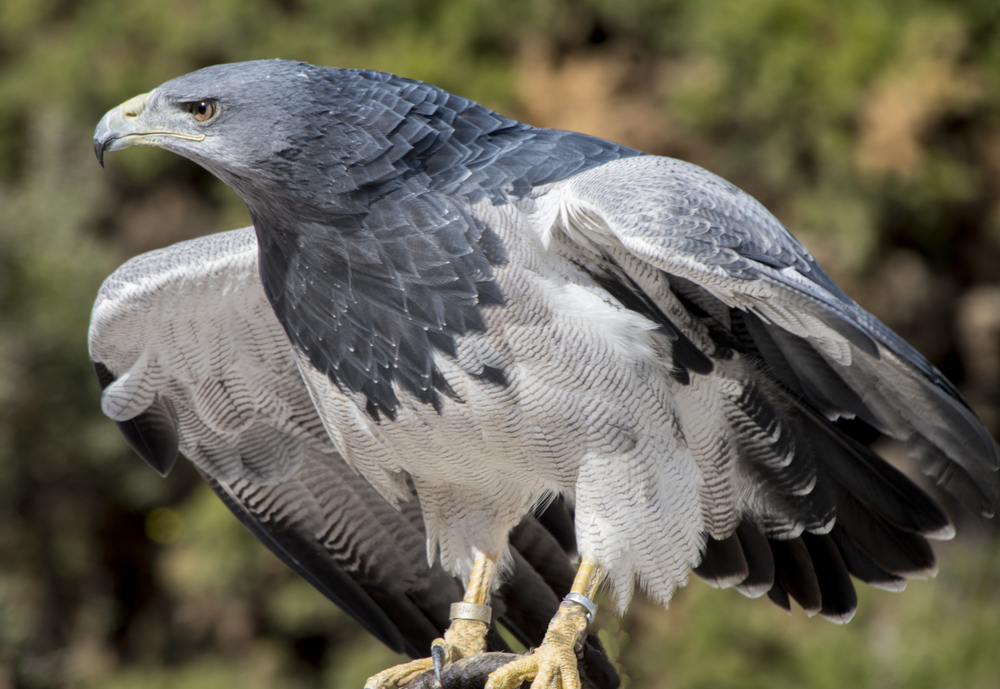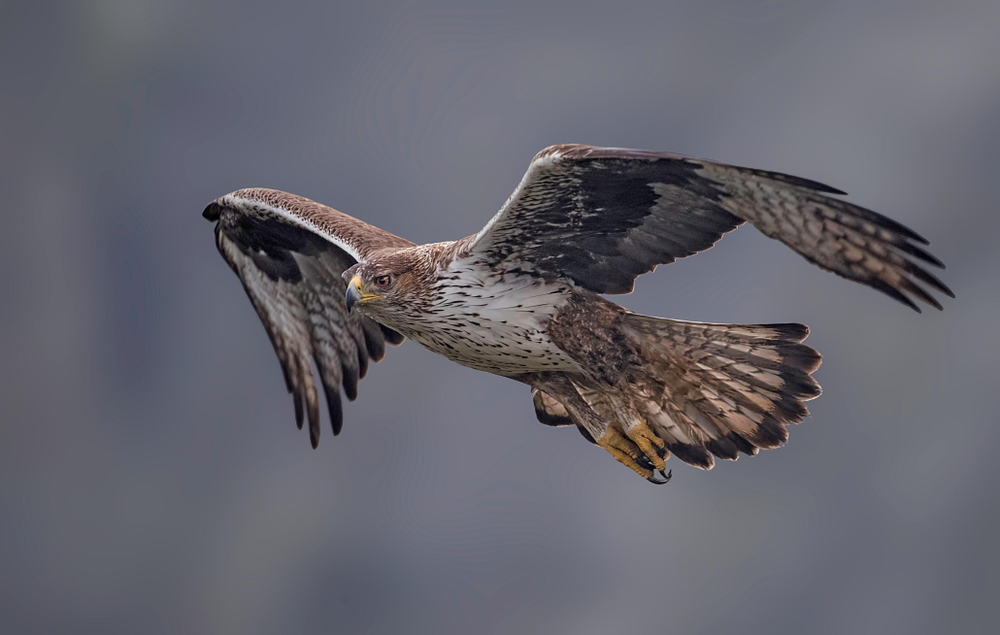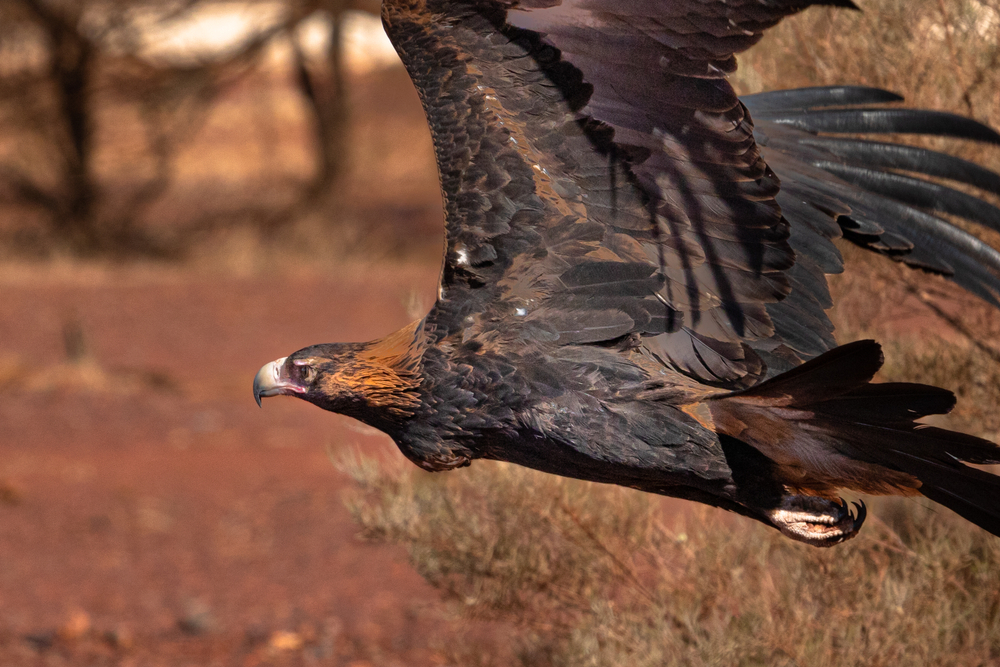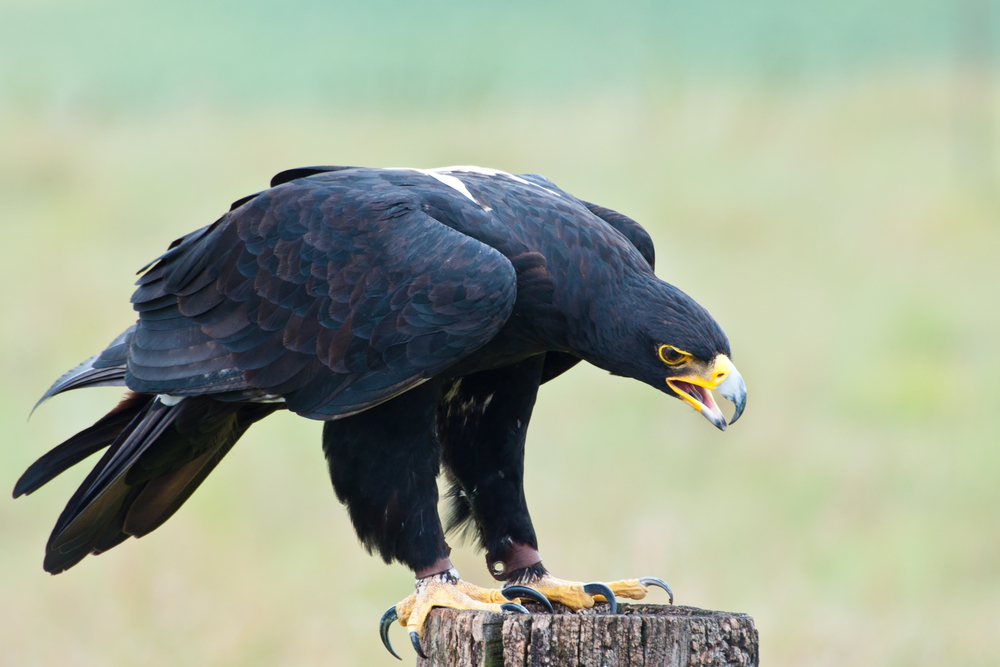The Martial Eagle’s closest relatives are other large booted eagles in the subfamily Aquilinae, particularly the Golden Eagle (Aquila chrysaetos) and the Wedge-tailed Eagle (Aquila audax). All share broad wings, feathered legs, and powerful talons suited for tackling large prey.
About
The Martial Eagle is the largest and most powerful eagle in Africa, renowned for its strength, sharp eyesight, and commanding presence across open savannas, woodlands, and semi-deserts. Found from sub-Saharan Africa to southern regions of the continent, it is an apex predator, capable of taking down prey much larger than itself. Its plumage is striking: dark brown upperparts, a white belly boldly spotted with black, and piercing yellow eyes that give it a fierce expression.
This eagle is immense, measuring 78–96 cm (31–38 in) in length with a wingspan of 188–260 cm (6.2–8.5 ft)—one of the largest among all eagles worldwide. Females, the larger sex, can weigh up to 6.5 kg (14 lbs). Martial Eagles are skilled hunters, often seen soaring at great heights before stooping rapidly to seize prey. Their diet is diverse, ranging from birds such as guineafowl to mammals including hyraxes, hares, and even young antelope. With crushing talons and immense power, they rank among the world’s most formidable raptors.
Breeding takes place in tall trees or sometimes on cliff ledges, where pairs build massive stick nests that may be reused for years. The female lays a single egg, and both parents help with incubation and feeding. Due to the long dependency of the chick—fledging after about 100 days and remaining reliant for several more months—pairs usually breed only once every two years. In the wild, Martial Eagles can live 14–20 years, though survival is increasingly threatened by human activity.
The scientific name of the Martial Eagle is Polemaetus bellicosus, and it belongs to the family Accipitridae, which also includes hawks, kites, and other eagles. Although still widespread, the species is declining due to habitat loss, persecution, and collisions with power lines. Today, it is listed as Vulnerable on the IUCN Red List. Admired for its size, power, and dominance in the African skies, the Martial Eagle is both an awe-inspiring predator and a species of conservation concern.
Physical Characteristics
The Martial Eagle (Polemaetus bellicosus) is Africa’s largest eagle and one of the most powerful raptors in the world, renowned for its size, keen eyesight, and formidable hunting ability.
Plumage:
Adults have dark brown upperparts with contrasting white underparts heavily streaked with dark brown spots. The head and upper chest are darker, blending into the lighter belly. The wings are long and broad, dark above and pale below with mottling. Juveniles are paler, with mostly white underparts and light brown upperparts, gradually darkening with age.
Head and Face:
They have a broad, dark head with striking piercing yellow eyes and a strong, hooked beak designed for tearing flesh. Their intense gaze gives them a fierce, commanding appearance.
Body and Wings:
Martial Eagles have a large, robust body with exceptionally broad wings, built for soaring effortlessly at great heights. Their long legs are feathered to the feet and armed with immense talons, capable of subduing large prey.
Size:
-
Length (Body): 31 to 38 in (78 to 96 cm)
-
Wingspan: 76 to 94 in (193 to 240 cm)
-
Tail Length: 11 to 14 in (28 to 35 cm)
Weight:
-
Males: 6.6 to 8.8 lbs (3 to 4 kg)
-
Females: 9.9 to 13.2 lbs (4.5 to 6 kg), making them significantly larger than males.
The Martial Eagle’s massive size, broad wings, and heavily spotted underparts make it one of the most distinctive and imposing eagles of the African savannas and open woodlands.
Reproduction
The Martial Eagle has a slow reproductive cycle, typical of large raptors, with high parental investment in raising a single chick.
1. Mating and Courtship:
Martial Eagles are monogamous and form long-term pair bonds. Courtship involves dramatic soaring displays, with the male performing steep dives and upward sweeps accompanied by loud calls.
2. Nesting:
Nests are massive, often 4 to 6 feet (1.2 to 1.8 m) across, built high in tall trees such as acacias or baobabs, occasionally on cliffs. Pairs reuse and refurbish the same nest for many years, adding fresh greenery each season.
3. Egg-Laying:
The female usually lays a single egg, occasionally two, though generally only one chick is raised. Eggs are whitish and unmarked.
4. Incubation:
Incubation lasts about 45 to 53 days, carried out mainly by the female while the male provides food.
5. Raising Chicks:
The chick hatches covered in white down. The female broods the chick closely during its early weeks, while the male delivers prey. As the chick grows, the female joins in hunting to meet the demands of the growing young.
6. Fledging and Independence:
The chick fledges at around 90 to 100 days, but remains dependent on its parents for several more months. Juveniles often stay in the parents’ territory for up to 6 to 12 months before dispersing.
The Martial Eagle’s reproductive strategy—single-egg clutches, long incubation, and extended care—ensures high survival rates for its young, but also means population growth is slow, making the species vulnerable to human pressures.
Lifespan
The Martial Eagle, Africa’s largest eagle, is a long-lived raptor whose survival depends on vast territories, prey abundance, and protection from human threats.
Lifespan in the Wild:
In natural conditions, Martial Eagles typically live 12 to 16 years, though some may reach 20 years in secure habitats. Juvenile mortality is high, particularly during the first year of independence, when young birds are still learning to hunt effectively.
Lifespan in Captivity:
In zoos or rehabilitation centers, Martial Eagles may live 25 to 30 years, benefitting from steady food supplies, veterinary care, and protection from human persecution.
Threats to the Martial Eagle:
-
Persecution: They are often shot or poisoned due to the mistaken belief that they threaten livestock.
-
Habitat Loss: Expansion of agriculture and settlements reduces nesting sites and prey availability.
-
Electrocution: Collisions with power lines pose a serious risk.
-
Food Scarcity: Declines in medium-sized mammals and game birds impact breeding success.
-
Slow Reproduction: With only one chick raised every 2 to 3 years, populations recover slowly from losses.
Care and Protection:
Conservation measures include habitat preservation, educating farmers, reducing persecution, and protecting nesting trees. Long-term survival requires large, undisturbed landscapes to sustain breeding pairs.
The Martial Eagle’s long lifespan and low reproductive rate make it both a symbol of African wilderness and highly vulnerable to human impacts.
Eating Habits
The Martial Eagle is one of Africa’s most formidable avian predators, with a varied diet that includes some of the largest prey taken by any eagle.
Diet:
Their prey consists mainly of medium-sized mammals and large birds, including hares, hyraxes, mongooses, guineafowl, bustards, and even young antelope. They also take reptiles such as large lizards and monitor lizards. Occasionally, they prey on domestic animals like poultry, which has contributed to conflict with humans.
Hunting Strategy:
Martial Eagles are soaring hunters, often seen circling at great heights with keen eyesight scanning for movement below. Once prey is spotted, they dive in a powerful stoop or glide low to ambush unsuspecting animals.
Killing Technique:
Prey is seized with their immensely powerful talons, capable of exerting crushing force. Small animals are killed instantly, while larger ones are subdued by repeated blows and suffocation from the eagle’s grip.
Feeding Behavior:
Martial Eagles often consume prey on the ground or carry it to a perch. Large kills may last for several days, especially when feeding a chick. Adults tear prey into smaller portions for nestlings during breeding season.
Special Considerations:
-
Large Prey Capacity: Known to take animals weighing up to 66 lbs (30 kg), although typical prey is much smaller.
-
Opportunistic Hunters: Their diet shifts based on regional prey availability, from game birds to small mammals and reptiles.
-
Ecosystem Role: As apex predators, they regulate populations of game birds and small to medium mammals, maintaining ecological balance.
The Martial Eagle’s sheer power, ability to capture large prey, and dominance in open habitats make it one of the most feared and respected raptors in Africa.
Uniqueness
The Martial Eagle is one of Africa’s most powerful and commanding raptors, admired for its size, strength, and ecological importance.
Largest Eagle in Africa:
With a wingspan reaching nearly 8 feet (2.4 m), the Martial Eagle is the largest eagle on the continent, built for soaring over vast savannas and woodlands.
Exceptional Eyesight:
They have some of the keenest vision of any eagle, able to spot prey from over 3 miles (5 km) away, making them superb aerial hunters.
Powerful Predator:
Known for tackling prey far larger than themselves, Martial Eagles have taken down animals such as young antelope and jackals, showcasing their unmatched hunting strength.
Soaring Specialist:
Unlike forest eagles such as the Harpy or Crowned Eagle, Martial Eagles are open-country hunters, spending much of their day soaring at high altitudes in search of prey.
Conservation Symbol:
Once widespread across Africa, their populations are now declining due to persecution and habitat loss. They are considered a vulnerable species and serve as a flagship for raptor conservation in African landscapes.
The Martial Eagle’s combination of immense size, incredible eyesight, and unmatched hunting power makes it one of the most unique and awe-inspiring raptors of the African skies.
Be the First to Share Photos of This Species.
FAQ’s
1. What is the closest species to the Martial Eagle?
2. How does the Martial Eagle compare to other eagles?
The Martial Eagle is the largest eagle in Africa, with a wingspan up to 8 ft (2.4 m) and the power to kill prey larger than itself, including antelope. Unlike forest hunters such as the Harpy or Crowned Eagle, it is adapted to open savannas and semi-arid landscapes, soaring for hours while scanning for prey with extraordinary eyesight.
3. What national parks provide the best chance to see a Martial Eagle?
Martial Eagles are found across sub-Saharan Africa. Some of the best parks to see them include Kruger National Park (South Africa), Etosha National Park (Namibia), Serengeti National Park (Tanzania), and Hwange National Park (Zimbabwe), where they soar high above open plains in search of prey.



































































